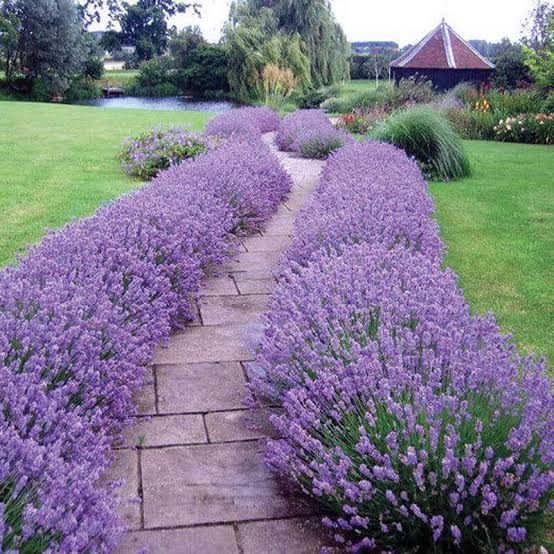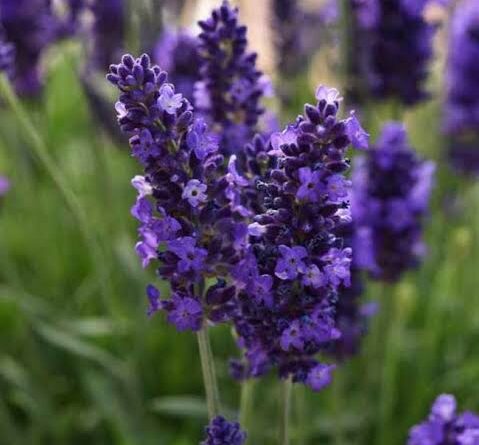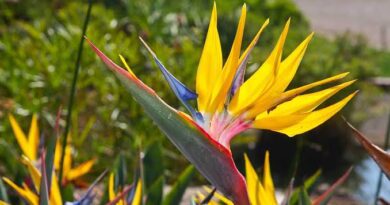Lavender Flower Complete Growing Guide
The lavender bush, with its delicate, purple-hued flowers and enchanting aroma, stands as one of nature’s most cherished gifts. Native to the Mediterranean region, this perennial shrub belongs to the Lamiaceae family and is renowned for its myriad uses, spanning from ornamental landscaping to therapeutic applications. Revered for centuries, the lavender bush captivates with its beauty, fragrance, and numerous health benefits, making it a treasured addition to gardens, homes, and holistic practices worldwide.
The lavender bush, scientifically known as Lavandula, is a hardy and evergreen shrub that can reach a height of up to three feet, adorned with slender, silvery-green leaves. However, it is the lavender’s majestic blooms that steal the limelight. The flower spikes, rising gracefully from the bush, boast a spectrum of colors ranging from soft lilac to deep violet, and their charm draws in an array of beneficial pollinators, such as bees, butterflies, and other friendly insects.
The most captivating aspect of the lavender bush is, undoubtedly, its enticing fragrance. When a gentle breeze sweeps through the garden, the air becomes infused with the sweet, floral, and herbaceous aroma that soothes the senses and lingers long after the bloom. This fragrance has earned lavender its place in perfumes, essential oils, and various cosmetic products, adding a touch of natural luxury to our daily lives.
Beyond its olfactory delights, the lavender bush offers a multitude of practical uses. In landscaping, these versatile shrubs make for stunning borders, hedges, or ornamental accents, lending a touch of elegance to any garden. When skillfully dried, lavender flowers can be incorporated into potpourri, sachets, and scented candles, infusing homes with a serene ambiance and promoting relaxation.
For centuries, lavender has been revered for its therapeutic properties. Its essential oil, extracted through distillation, is renowned for its soothing and calming effects. It is often used in aromatherapy to alleviate stress, anxiety, and insomnia, helping individuals find solace in the midst of life’s frenetic pace. Lavender oil is also celebrated for its anti-inflammatory and antimicrobial properties, making it an excellent choice for treating minor skin irritations and promoting wound healing.
The lavender bush’s allure extends to the culinary world as well. Lavender-infused delicacies have graced the tables of gourmets and culinary enthusiasts for ages. The flowers’ subtle flavor, reminiscent of floral notes with a hint of citrus, can enhance a variety of dishes, from desserts and teas to savory recipes. Lavender complements sweet treats like lavender-infused honey, ice creams, and biscuits, while also adding a unique twist to savory dishes like lavender-infused marinades and dressings.
Cultivating and maintaining a flourishing lavender bush requires some care and consideration. Lavender thrives in well-drained soil, plenty of sunlight, and moderate water conditions, making it ideal for gardens in sunny, arid climates. Pruning after blooming helps stimulate new growth and maintain the bush’s shape, ensuring a healthy and vigorous lavender plant year after year.
In addition, the lavender bush transcends mere ornamental beauty. Its beguiling fragrance, coupled with its versatility and therapeutic benefits, elevates it to a cherished status among nature’s botanical treasures. Whether adorning a garden, enhancing the aroma of a home, or soothing the mind and body, the lavender bush continues to weave its fragrant
Growing lavender
Lavender, with its beautiful flowers and captivating aroma, is a beloved herb that can add charm and tranquility to any garden. If you’re interested in growing lavender, whether for its ornamental value or its versatile culinary and therapeutic uses, here are some tips to help you cultivate this delightful herb successfully.
Choose the Right Variety: There are several varieties of lavender available, each with its unique characteristics. The most common types include English lavender (Lavandula angustifolia), French lavender (Lavandula dentata), and Spanish lavender (Lavandula stoechas). Research the different varieties and choose the one that suits your climate, soil conditions, and desired purpose.
Select a Sunny Location: Lavender thrives in full sun, so choose a location in your garden that receives at least six to eight hours of direct sunlight each day. Lavender plants require ample sunlight to grow and produce abundant blooms.
Prepare Well-Draining Soil: Lavender prefers well-draining soil with a slightly alkaline to neutral pH. Ensure that the soil is loose and sandy, as lavender does not tolerate wet or waterlogged conditions. If your soil is heavy clay, consider amending it with sand, gravel, or organic matter to improve drainage.
Planting Lavender: Plant lavender in the spring or fall when the soil is warm and workable. Space the plants about 12 to 18 inches apart to allow for good airflow and prevent overcrowding. Dig a hole slightly larger than the root ball, place the plant in the hole, and backfill with soil. Gently firm the soil around the base of the plant.
Watering and Care: Lavender is a drought-tolerant herb and prefers moderate water conditions. Initially, water the plants regularly to establish the root system. Once established, reduce watering frequency, allowing the soil to dry out between waterings. Overwatering can cause root rot and other issues, so it’s important to strike a balance.
Pruning and Maintenance: Prune lavender plants annually to promote bushier growth and prevent legginess. After the first bloom, trim the spent flower stems back to just above the foliage. In early spring, before new growth emerges, lightly trim the lavender bushes to shape them and remove any dead or damaged branches.
Harvesting Lavender: Lavender is best harvested just before the flowers fully open, typically in the morning when the aromatic oils are at their peak. Cut the flower stems with a sharp pair of pruning shears, leaving a few inches of foliage intact. Bundle the stems together and hang them upside down in a warm, dry, and well-ventilated area to dry. Once dry, remove the flowers from the stems and store them in airtight containers away from direct sunlight.
Pests and Diseases: Lavender is generally resistant to pests and diseases. However, keep an eye out for common issues like aphids, spider mites, and fungal diseases. Regularly inspect your plants, and if necessary, use organic pest control methods or consult with a local gardening expert for appropriate remedies.
By following these tips, you can cultivate a thriving lavender garden that delights the senses and provides you with an abundance of fragrant flowers. Remember to enjoy the process and take the time to savor the beauty and therapeutic benefits of this remarkable herb.
Read Also: Categorization, Damages Caused, Diagnosis and Control Methods of Plant Diseases
Phnenomenal lavender

When it comes to lavender, one variety stands out as truly exceptional: Phenomenal lavender (Lavandula x intermedia ‘Phenomenal’). As its name suggests, this lavender cultivar exhibits qualities that set it apart from the rest. From its striking appearance to its unparalleled hardiness, Phenomenal lavender is a remarkable choice for garden enthusiasts and lavender lovers alike.
Appearance and Fragrance:
Phenomenal lavender showcases an elegant and robust stature, reaching a height of up to 2 to 3 feet. Its silver-green foliage forms a dense mound, providing a beautiful backdrop for the stunning purple-blue flower spikes that rise above it. The flowers, held on long stems, create a visual spectacle and emit a captivating aroma that is characteristic of high-quality lavender.
Superior Hardiness:
One of the most remarkable attributes of Phenomenal lavender is its exceptional hardiness. This variety is known to withstand a wide range of climates and environmental conditions, making it suitable for both hot and cold regions. It thrives in USDA hardiness zones 5 to 9, exhibiting excellent tolerance to heat, humidity, and cold temperatures as low as -20°F (-29°C). Whether you reside in a scorching summer climate or a frosty winter region, Phenomenal lavender can brave the elements and continue to flourish.
Disease and Pest Resistance:
Phenomenal lavender possesses a natural resistance to common lavender diseases and pests. It demonstrates increased resistance to root rot, a prevalent issue that often affects lavender plants. This resilience is attributed to its improved root system, which allows for better water drainage and prevents waterlogged conditions that can lead to disease development. Additionally, Phenomenal lavender exhibits resistance to foliar diseases and pests, minimizing the need for chemical interventions and making it an ideal choice for organic gardeners.
Long-Lasting Blooms:
One of the delights of Phenomenal lavender is its prolonged blooming period. The flower spikes emerge in early summer and persist throughout the season, extending well into fall. This extended blooming time allows for a more extended period to enjoy the fragrant beauty of lavender and provides ample time for pollinators to visit, attracting bees, butterflies, and other beneficial insects to your garden.
Versatile Uses:
Phenomenal lavender offers a wide range of uses, both ornamental and practical. Its striking appearance makes it an excellent choice for landscaping, whether used as a border, in garden beds, or as a focal point in mixed perennial gardens. The aromatic flowers can be harvested and dried for use in potpourri, sachets, and floral arrangements, infusing your home with the relaxing and enchanting fragrance of lavender. Additionally, Phenomenal lavender’s essential oil can be extracted for use in aromatherapy, homemade skincare products, and culinary delights, adding a touch of lavender’s therapeutic properties and flavor to various creations.
In addition, Phenomenal lavender is aptly named, for it truly embodies extraordinary qualities that make it a standout variety among lavender enthusiasts. Its striking appearance, exceptional hardiness, disease resistance, long-lasting blooms, and versatile uses make it a phenomenal choice for gardens and landscapes. By introducing Phenomenal lavender to your outdoor space, you invite a world of beauty, fragrance, and resilience that will continue to captivate and inspire for years to come.
Read Also: Cutworms: How to Identify and Get Rid of Cutworms
Hidcote lavender

Hidcote lavender (Lavandula angustifolia ‘Hidcote’) is a renowned cultivar that has captured the hearts of lavender enthusiasts and gardeners for generations. Named after the famous Hidcote Manor Garden in England, where it was first cultivated, this lavender variety exudes a classic charm and a distinctive set of characteristics that make it highly sought after. From its compact form to its intense fragrance, Hidcote lavender encapsulates the essence of timeless beauty and elegance.
Compact Form and Silvery Foliage:
Hidcote lavender is known for its compact and bushy growth habit, reaching a height of around 1 to 2 feet (30 to 60 cm). This makes it an excellent choice for small gardens, borders, containers, and even as a low hedge. Its narrow, gray-green foliage forms a dense mound, providing an attractive backdrop for the vibrant purple flower spikes that emerge during the blooming season.
Deep Purple Blooms and Intense Fragrance:
The true allure of Hidcote lavender lies in its stunning deep purple blooms. The flower spikes, held on long stems, rise above the foliage, creating a visual feast of color and texture. These fragrant blossoms not only add a touch of vibrant beauty to the garden but also emit an intense and captivating aroma. The scent of Hidcote lavender is often described as sweet, floral, and rich, making it a delightful addition to any garden or sensory experience.
Extended Blooming Period:
One of the advantages of Hidcote lavender is its extended blooming period. The flowers typically start to appear in late spring or early summer and continue to grace the garden with their presence well into mid-summer. This extended blooming time allows for an extended period of enjoyment and provides ample opportunities for harvesting the flowers for various uses.
Versatility in Uses:
Hidcote lavender offers a wide range of uses, both ornamental and practical. Its compact form and vibrant blooms make it an ideal choice for borders, edging pathways, or creating stunning mass plantings. The aromatic flowers can be harvested and dried for use in potpourri, sachets, or homemade lavender products, infusing your living spaces with a soothing and enchanting fragrance. Hidcote lavender’s essential oil is highly valued in aromatherapy for its calming and relaxing properties. Additionally, the flowers can be used in culinary applications, adding a touch of lavender’s distinctive flavor to baked goods, beverages, or savory dishes.
Caring for Hidcote Lavender:
To ensure the health and vitality of your Hidcote lavender, provide it with a sunny location that receives at least 6 to 8 hours of direct sunlight each day. Well-draining soil is essential to prevent waterlogging, as lavender does not tolerate excessive moisture. Regular pruning, typically done after blooming, helps maintain its compact form and encourages new growth. Hidcote lavender is a drought-tolerant plant, but it will benefit from occasional deep watering during prolonged dry periods.
However, Hidcote lavender epitomizes the timeless beauty and classic elegance of this beloved herb. Its compact form, deep purple blooms, intense fragrance, and versatility make it a cherished choice among lavender enthusiasts and gardeners alike. Whether adorning a garden, enhancing a sensory experience, or adding flavor to culinary creations, Hidcote lavender brings a touch of refinement and allure to any setting.
Culinary lavender
Culinary lavender, with its delicate and aromatic blooms, offers a unique and enchanting flavor that can elevate a wide range of culinary creations. Known for its sweet and floral notes, lavender has long been cherished by chefs and home cooks alike for its ability to add a touch of elegance and intrigue to both sweet and savory dishes. Whether used as a key ingredient or a subtle garnish, culinary lavender can transform ordinary recipes into culinary delights.
Choosing Culinary Lavender:
When selecting lavender for culinary purposes, it’s essential to choose a variety that is specifically labeled as suitable for culinary use. The most commonly recommended culinary lavender is Lavandula angustifolia, also known as English lavender. This variety is prized for its milder flavor and pleasant aroma, making it a versatile choice in the kitchen.
Flavor Profile and Pairings:
Culinary lavender imparts a distinct floral and slightly herbal flavor to dishes. The flavor can range from subtle to more pronounced, depending on the amount used and the specific variety of lavender. When using culinary lavender, it’s important to strike a balance, as too much can overpower a dish.
Lavender pairs well with a variety of ingredients, both sweet and savory. In sweet dishes, lavender adds a unique twist to desserts, baked goods, and beverages. It complements flavors such as lemon, berries, vanilla, honey, and chocolate, infusing them with a delicate floral undertone. Lavender can be used to flavor ice creams, sorbets, cookies, cakes, custards, and even homemade syrups or infused sugars.
In savory dishes, culinary lavender can enhance the flavors of meats, poultry, vegetables, and sauces. It pairs well with ingredients like lamb, chicken, roasted vegetables, citrus, honey, and herbs such as thyme or rosemary. Lavender can be incorporated into marinades, rubs, dressings, and sauces, adding a subtle floral complexity to the savory profiles.
Using Culinary Lavender:
When using culinary lavender, it is recommended to start with small amounts and adjust according to personal taste. Here are a few tips for incorporating culinary lavender into your culinary creations:
Dried Lavender: Culinary lavender is often used in its dried form. Crush the dried flowers gently with your fingers or use a mortar and pestle to release their aroma and flavor. This helps distribute the lavender more evenly throughout the dish.
Infusions and Extracts: Lavender can be infused into liquids, such as milk, cream, or syrups, to impart its flavor. Heat the liquid gently and steep dried lavender flowers in it, then strain before using. Alternatively, lavender extracts and essences can be used sparingly for a concentrated flavor.
Garnishing: Whole or partially crushed lavender buds can be used as a garnish for dishes, adding visual appeal and a subtle fragrance. Sprinkle a few buds on top of desserts, salads, or even cocktails for an elegant touch.
Quality and Storage:
To ensure the best flavor and quality, use culinary lavender that is specifically labeled for culinary purposes and is free from pesticides or additives. Store dried lavender in an airtight container in a cool, dark place to preserve its flavor and aroma.
In addition, culinary lavender is a versatile and enchanting ingredient that can add a delicate floral touch to a wide range of culinary creations. Its unique flavor profile and versatility make it a cherished addition to both sweet and savory dishes, allowing cooks to explore new dimensions of taste and aroma. So, unleash your creativity in the kitchen and let culinary lavender inspire you to create culinary masterpieces infused with its captivating essence.
Read Also: The Essential Guide to Startup Marketing Job Description









